From decades of traveling the world with my camera, I’ve learned – sometimes the hard way – that a camera rain cover is an essential part of any photographer’s kit. Here’s why: The most dramatic skies for landscape photography often occur during those brief moments before and after a storm. Either side of that moment, you’re probably going to get wet. If wildlife photography is more your cup of tea, I also have news for you: many animals don’t care about the rain. They’ll still be out there doing what they’ve got to do.
Having spent all that time, effort, and money getting yourself to the correct location at the right time, with the right gear, will you risk it all on “I’ll get the shot later when the weather is better”? The smart move is to carry a simple rain cover and get a shot in the bag. There’s a good chance it’ll have more natural drama and tell more of a story than a shot in dry weather.
Finally, if event shooting is your day-to-day gig, you will eventually get a wet one. And then your reputation as a professional is on the line. You still need to deliver. The lack of an essential accessory that can cost less than a visit to Starbucks will not fly as an excuse. For all these reasons, I always carry a camera rain cover in my camera bag. After much research and years of testing, from the jungles of Cambodia to the tundra of Canada’s Arctic Circle, I will outline my top picks in this guide.

Table of Contents
In a Hurry? My Quick Pick
If you’re in a hurry and need a quick solution that’s cheap, packable, and twenty times better than a garbage bag, you can’t go wrong with the Think Tank Emergency Rain Cover. Available in Small, Medium, and Large sizes, these covers work with DSLR or mirrorless cameras and don’t require the purchase of an additional eyepiece. I generally keep one of these in my camera bag at all times. Still, there are occasions in which I choose other options, and these are discussed in the remainder of the guide.
Best Rain Covers for Your Camera
Think Tank Hydrophobia V3
I have used Think Tank’s Hydrophobia rain covers for over a decade, using the V1 models, then V2, and now the latest V3 models. If you’ve ever thought to yourself, “I wish I could get a camera rain cover that’s just like my GoreTex rain jacket,” the Hydrophobia covers are the answer, and they are available in three sizes:
- Hydrophobia 300-600 V3 – For cameras with a lens size between 300mm and 800mm
- Hydrophobia 70-200 V3 – For cameras with medium-telephoto zoom lenses such as 70-200mm, 100-400mm, 100-500mm
- Hydrophobia 24-70 V3 – For cameras with short primes, wide-angle, and standard zooms such as 24-70mm, 24-105mm, 16-35mm, or 14-24mm
All of the Hydrophobia covers come with a front element cover that is tethered to the main cover and can be used to stop water from getting onto the front of your lens when you’re waiting to shoot or walking around. I’ve always found that useful, and it surprises me that none of the other rain covers on the market offer this simple feature.
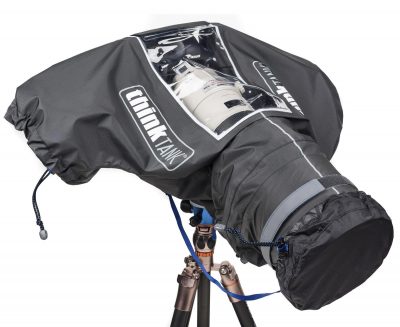




Another cool feature unique to the Hydrophobia series is that all covers except for the 300-600 version come with an integrated camera strap. Inside the rain cover is a nylon loop that wraps around the lens to support the lens and body with the strap. That means that the weight of your camera isn’t hanging directly off the strap attachment point on the cover. Don’t worry; if you have a favorite camera strap that you want to use instead of the supplied Think Tank one, you can attach it just as you would to a camera. I like to use the Peak Design Slide straps with their quick-release system to quickly remove the strap from the camera and attach it to the rain cover.
As well as the lengthy feature list, you get Think Tank’s famed build quality and friendly customer service should you ever need it. All the zippers are seam sealed, and all the stitched seams in the durable 3-ply nylon are taped just like a waterproof hiking jacket would be. These covers are built for long-term professional usage, so they have price points reflecting that. Still, they certainly aren’t overpriced when you consider the quality of the construction and features that other covers don’t have.
The 300-600 V3 also has a neat trick to deploy the cover quickly. Rather than storing it in your bag, you can keep it on the lens hood of your super telephoto lens by strapping it on and then folding the cover into a pouch that wraps around the lens hood. This feature is designed for sports photographers who can’t afford to spend a lot of time attaching the cover if a rainstorm strikes midway through a game. If you think you might have rain during your game/match/race, pre-install the cover onto the lens hood, and then you can pull it over the camera in just a couple of seconds when the skies open. A quick scan of the sidelines at a major sporting event on a day with questionable weather will reveal many of these Think Tank Hydrophobia covers.
One thing to be aware of is the need to buy a special eyepiece for your camera when you purchase the rain cover. This eyepiece is important because it’s needed to properly seal with the rubber gasket on the back of the cover. When weighing up your purchasing decisions, make sure you factor in the additional cost of the eyepiece, which is $20.
Think Tank Emergency Rain Cover

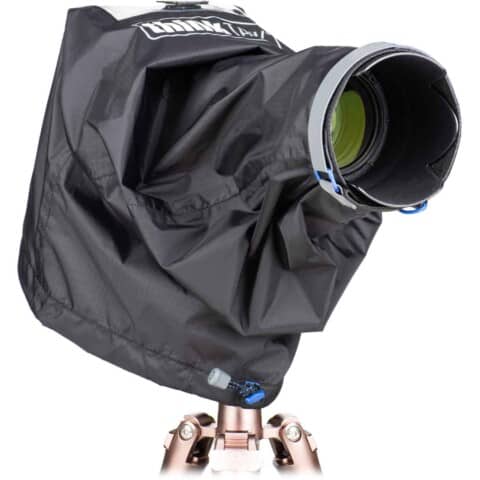

The Emergency Rain Cover series is the simpler sibling to the Think Tank Hydrophobia. Available in small, medium, and large sizes, these covers feature a rubber-covered hook-and-loop strap around the front of the lens and an ingenious hot shoe attachment that keeps the cover in place on the camera. The back of the rain cover has a clear plastic panel that lets you see the camera’s LCD screen. You can temporarily lift up the cover to access the camera’s viewfinder. An elastic drawcord around the bottom of the cover enables tripod mounting.
- Emergency Rain Cover Small – For cameras with short primes, wide-angle, and standard zooms such as 24-70mm, 24-105mm, 16-35mm, or 14-24mm
- Emergency Rain Cover Medium – For cameras with medium-telephoto zoom lenses such as 70-200mm, 100-400mm, 100-500mm
- Emergency Rain Cover Large – For cameras with a lens size between 300mm and 800mm
The Emergency Rain Cover series perfectly blends form, function, and price. Importantly, they are not so big and bulky that you never want to carry them with you. That’s the whole point, after all. They need to be there for emergencies. All three sizes are small enough to squash into even the smallest pockets in a camera bag.
Vortex Media Pro Storm Jacket
These Vortex Storm Jacket rain covers are a simple tubular design with elasticated cords at both ends to cinch tight around the lens hood and the back of the camera. There’s plenty of room to slide your right hand under the cover to get to the camera, and once you push your eye up to the viewfinder, the cover has enough excess material that it still generally keeps the rain off the back of the camera.
The Storm Jackets come in two variations: Standard and Pro. The only difference is that the Pro version has a hook and loop closure along the bottom of the cover that can be used to poke a tripod or monopod through to the camera. As you can see in the photo above, it’s also handy for a gimbal head. To find the correct length for your needs, combine the length of your camera and your lens and then add 2 or 3 inches. The covers are highly compressible, so it’s possible to buy one for your largest lens and still make it work with a much shorter lens.

- Small — 11″
- Medium — 17″
- Large — 23″
- X-Large — 27″
- XX-Large — 31″
I love that these covers are so light that you can carry them in your bag all the time “just in case.” Some other rain covers are so big and bulky that you’d never take them with you unless you thought there was a good chance of rain. With the Storm Jacket, you can stash it in a tiny pocket in your bag, and you’ll forget it’s there until you need it.
Ruggard P18 Rain Cover


There are several cheap, clear plastic camera rain covers on the market, but the Ruggard P18 stands out from this crowd by offering enough additional plastic at the back of the cover to protect your hands from the rain. A single cover is available for under $7, and the P18 is available in a selection of different sizes to suit different cameras and flash combinations.
If your budget is constrained, this is certainly better than nothing and better than a garbage bag. Personally, I think it’s worth spending $40 on something far more robust like the Think Tank Emergency Rain Cover, but I wanted to include a super cheap option on the list as I know some people will appreciate that. If you’re going for the affordable plastic solution, I think this is the best.
Environmental note: In a world generating far too much plastic waste, I urge you not to purchase a cheap plastic cover like the Ruggard P18 and only use it once. Please, if you buy one of these ultra-cheap covers, do not treat it as a single-use product!
LensCoat RainCoat RS (Camo)
LensCoat has an extensive and confusing range of camera rain covers. I have tested them, and there are two worth considering. The first is the LensCoat RainCoat RS (rain sleeve). This is the most straightforward rain cover they make. It has the same open-backed design as the Vortex Media Storm Jacket or the Think Tank Emergency Rain Cover but is made from much thicker materials.
Since the RainCoat RS uses a much heavier material than the Vortex or Think Tank options, it’s bulkier and heavier. That’s a definite disadvantage for a more expensive cover, and it doesn’t offer any more protection from the rain to compensate for that.
Where the RainCoat RS does have an advantage, and the reason it still makes it onto this list, is the choice of camouflage patterns. I wouldn’t bother buying a black RainCoat RS. Still, if you need to camouflage yourself for wildlife photography, then it might be worth considering one of the many available RainCoat RS camo patterns, such as Realtree® Max4, Realtree® Max5, and Realtree AP Snow.
LensCoat RainCoat 2 Standard (Camo)
The LensCoat RainCoat 2 Standard is a beefed-up version of the RainCoat RS with two arm holes to reach the camera body and the lens barrel. Unlike other big covers, such as the Think Tank Hydrophobia, the RainCoat 2 Standard has an open-back design that some people find easier to use. The more straightforward design also keeps the price point a little lower.
Peak Design Shell



The Shell Rain Cover from Peak Design is an excellent little cover for anyone using the Peak Design Capture Clip. The Capture Clip allows you to carry your camera on a belt or the strap of your backpack, but this exposes it to the weather. The Shell rain cover is designed to slip quickly on and off the camera while attached to the Capture Clip.
It’s important to note that this cover is designed to protect the camera while you walk around with it attached to your body or bag. It is not intended to protect your camera while you are shooting. You cannot keep the Shell rain cover on the camera while you are shooting because it doesn’t have an eyepiece to look through. This makes its protection more limited than most other covers on this list. Whether that’s okay with you depends on how much weather sealing your camera and lens have.
Altura Photo Professional Rain Cover



The Altura Professional Rain Cover is this list’s best-value camera cover. From an environmental standpoint, I’d love to see people spending a few dollars more on this cover than the plastic ones that won’t last as long. This is one of the most popular rain covers, with a 4.3/5 rating on Amazon after well over 3000 reviews.
When you handle the cover, there’s very clearly a difference in quality between the Altura rain cover and the more expensive options. Still, with care, it will be acceptable for occasional emergency use. It’s undoubtedly a significant step up from the clear plastic covers. The downside is that this cover doesn’t have an eyepiece, so you must peer through the plastic to see your LCD screen or viewfinder.
The cover is available in just one size and only from Amazon, which is a limitation since it feels big if you use it with a small prime lens or a wide-angle zoom. It’s large enough to fit a 70-200mm f/2.8 or 100-500mm zoom.
Rain Covers for On-Camera Flash Users

A reader emailed me and asked for advice on which rain cover they should use if they need to mount a flash on top of their camera. Most rain covers completely cover the camera’s hot shoe, and they don’t have clear material on top to allow for flash use. While there used to be flash-compatible versions of the original Think Tank Hydrophobia and several other popular covers, these have been discontinued as photographers have transitioned away from this shooting technique.
The main reason is that flash photography doesn’t look great in the rain. It tends to light up all the raindrops more than the intended subject, creating bright spots of distraction across the image. These days, people are more likely to use modern cameras’ much-improved high ISO capabilities to compensate for low light on a dark, rainy day. That said, Ruggard does make a flash-compatible version of the P18 rain cover. The downside is that if you use it without a flash, you have some extra material to deal with, flopping about on top of the camera.
Rain Covers for Use With On-Camera Microphones

Another question asked on this topic was a recommendation for a rain cover that would work with an on-camera microphone. If you plan to use a microphone in the rain, you’d have to be careful not to pick up the pitter-patter of raindrops on the rain cover. Still, you might get acceptable results with a good shotgun mic that rejects sound around the camera. In this case, whether shooting with a mirrorless camera or a dedicated video camera, a video camera rain cover will be your best bet. The Manfrotto CRC series covers have a waterproof sleeve to enclose a shotgun microphone.
A Note for Side-Mount Gimbal Users
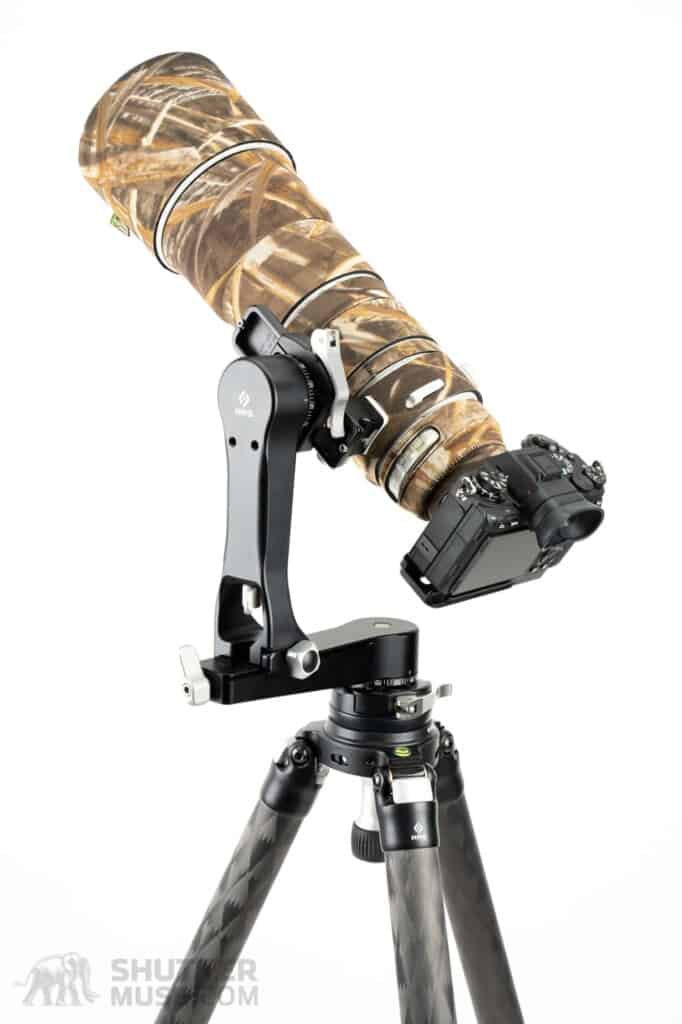
Most rain covers have an opening in the bottom that allows you to use them with a tripod. If you use a side-mount gimbal such as the Wimberley Sidekick or an RRS PG-02 without the cradle, this can narrow your rain cover options because you need an opening on the side of the cover and not the bottom. There are no rain covers on the market that are designed with this in mind, but you can make do by using a rain cover with two arm holes.
When using a rain cover with arm holes, you simply put the gimbal attachment through the left-hand arm hole, and if you need to control a zoom ring, you put your left hand up through the hole on the bottom of the cover that is meant for the tripod. This solution works very well with the Think Tank Hydrophobia 300-600, so that would be my pick for side-mount gimbal users.


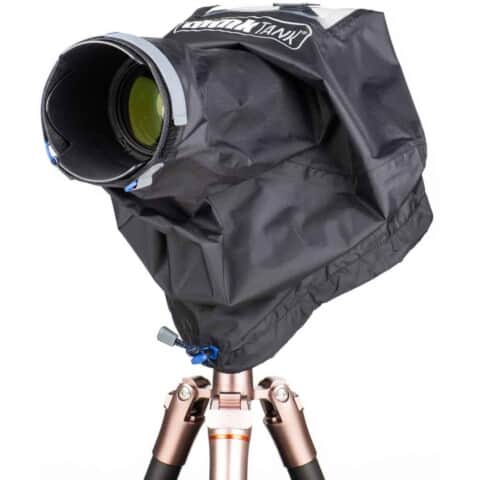

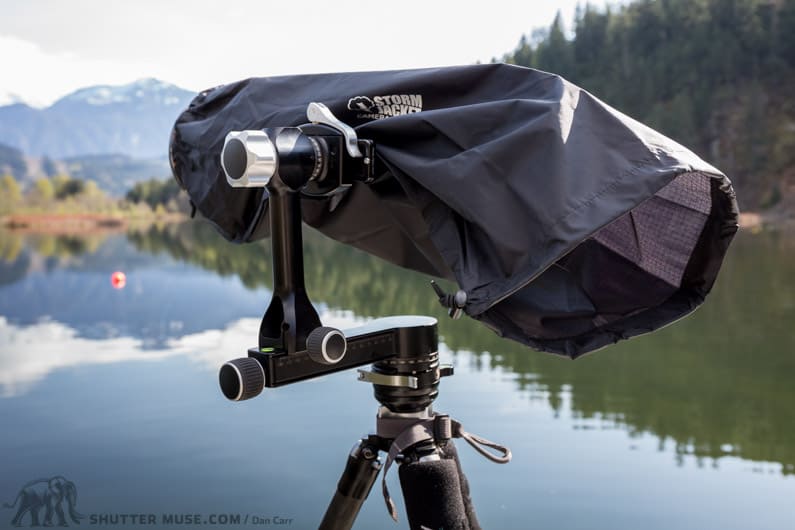

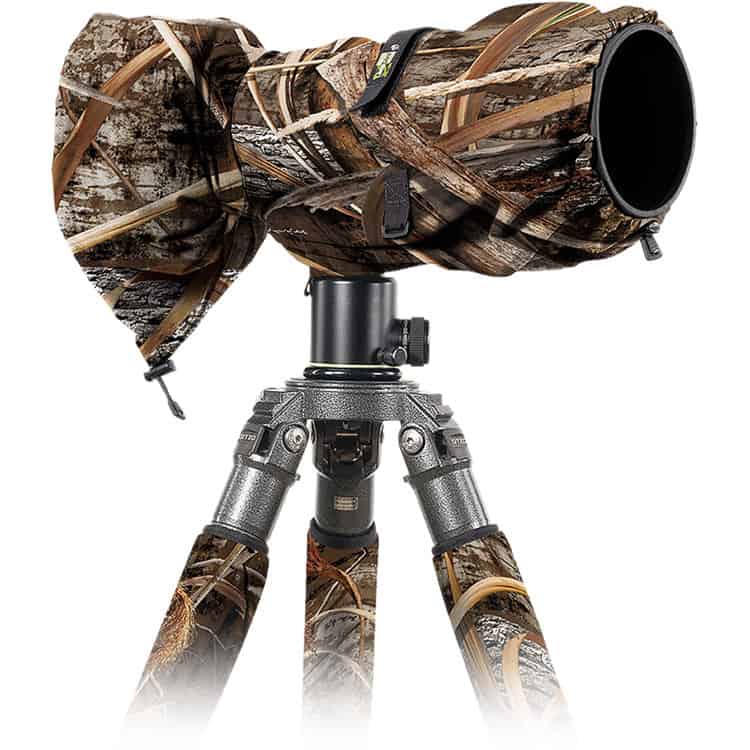
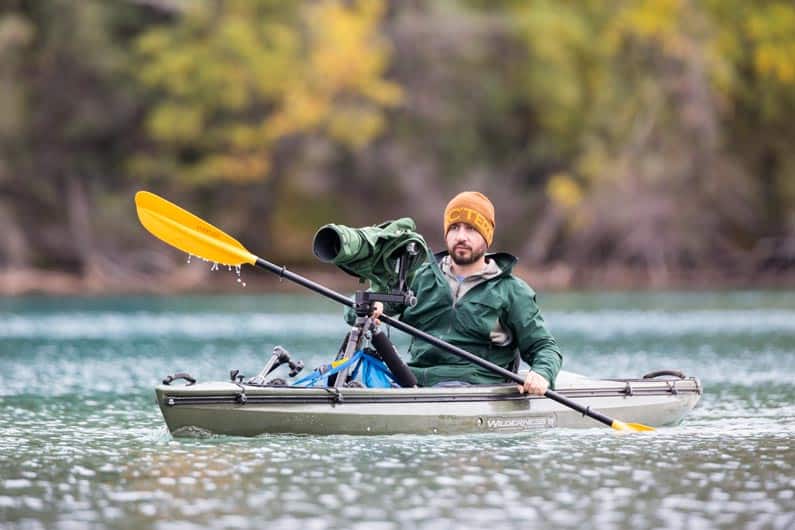

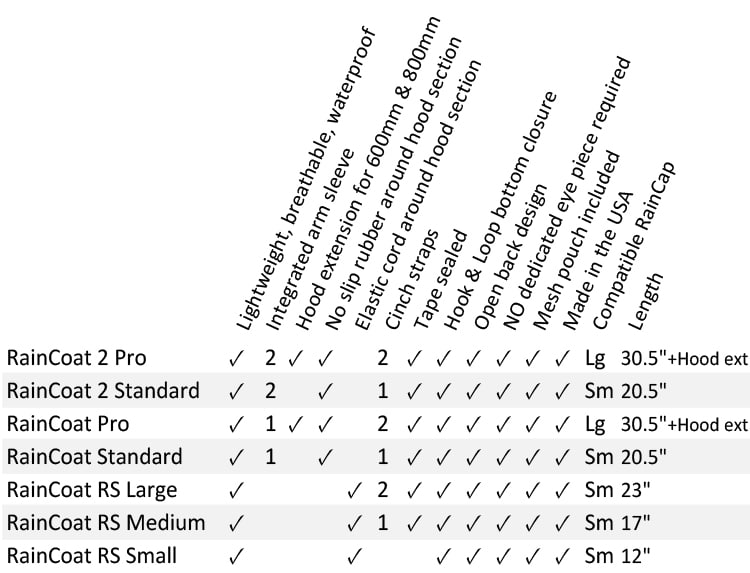


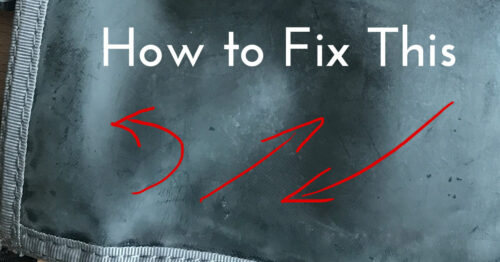
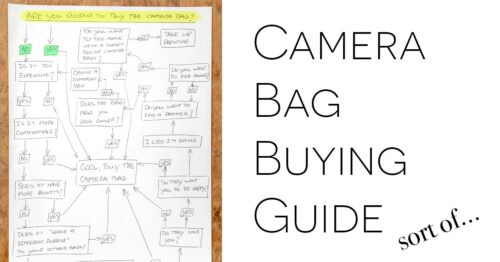

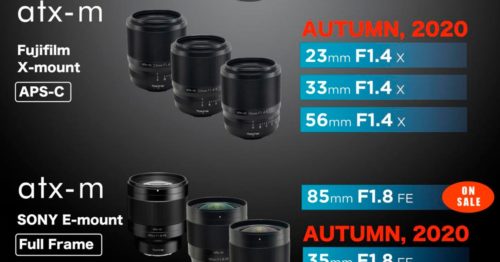
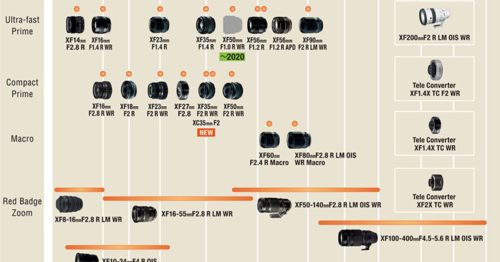
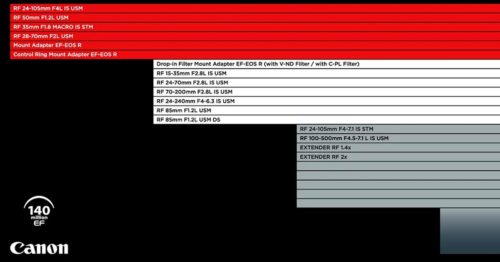
Interesting article and review piece, and to be honest it is not something I think much about. I’m an amateur hobbyist, so no commercial work or definite reason to HAVE to shoot in the rain. But you are right in that you never know when that opportunity may come.
Of all of the reviewed items, I have the PD shell. In fact, I have two. I have found them very useful when out walking with the camera on the capture clip, especially when rain looks likely. And although the quality of the material is fantastic, as well as how they can be removed/attached with great ease, you are absolutely correct in that not being able to use the camera whilst the shell is on it is a definite disadvantage and quite a disappointment in an otherwise excellent product.
I’ll need to have a think about which of the products, above, would suit me back home in rainy Scotland!
Thanks for taking the time to comment, Scott! I’m glad it provoked a bit of thought.
Thank you for this great review of camera rain covers, I’m a landscape photographer and unfortunately I can’t find or better saying I’m still surprised how this developers haven’t build a cover for landscape photographers who use filter systems.
Yeah, although to be honest, so few people use filter systems that I think it would be a tiny market. Even fewer people would continue to use one in the rain… I think your best bet is to use an umbrella holder clamped to your tripod 🙂
Good evening. I read your article with much interest and I came to the conclusion that I really need a camera cover for the rain because here in Italy weather is changing. It’s like in my mother country where it rains almost daily during raining season.
Unfortunately I got a problem. I own a mirrorles EOS M50 and its compactness that makes it easy to carry during trips is a disadvantage when it comes to these rain covers. I just bought a cover similar to the Altura one. It is simply too big even if the camera can fit inside properly with the needed attention.
I saw online the Movo Photo CRC11 cover and I was thinking to buy it, especially because soon I will be in USA and we will visit the Niagara Falls. If you know this cover do you suggest it to me? By what I saw it resemble a little the Vortex Media Pro Storm Jacket.
You are right, it is a problem to get very small rain covers for mirrorless cameras. I think the small Vortex covers would be a good options but I don’t know anything about the Movo.
I own a Canon 6D and variety of lenses like 50mm, 40mm, 70-200mm, 11-16mm, and a fish eye lens.
Which according to you would suit me the best and has value for money?
Thanks
*I am looking to shoot in extreme rains too
I think you should get the Think Tank Hydrophobia 70-200 v3. It’ll be fairly bunched up when using your shorter lenses, but it’s still workable. Whereas if you got the Hydrophobia 24-70, it’s not going to cover your 70-200, which is your most expensive lens. https://www.thinktankphoto.com/collections/hydrophobias/products/hydrophobia-d-70-200-v3-0-rain-cover?rfsn=140348.1cb649
Good morning. Is there a rain jacket that is better if you are not using a tripod? My daughter taking pictures for her school football team games, practices, etc. It looks like in every picture of a rain jacket cameras are on a tripod….she doesn’t use a tripod because she is constantly moving around sidelines.
Good question! Any of these will work without a tripod. I’m not sure why there are always tripod in the photos. Just an odd coincidence!
I have a Fujifilm Xh1, and want to buy the hydrophobia. But can’t find an eyepiece for it.
How do I go about it ?
Unfortunately I think you are out of luck. Think Tank don’t make an eyepiece for Fuji. Your best option is to use the more universal design of their “Emergency Rain Cover” which doesn’t require an eyepiece.https://www.thinktankphoto.com/collections/camera-rain-covers/products/emergency-rain-cover-medium?rfsn=140348.1cb649
This is very useful. Thanks.
Got a bird-shooting pelagic cruise coming up, with spray as a no-cost extra!
Glad to hear it. Have a great trip!
Great article and very informative. One thing that I’m always interested in knowing but doesn’t ever seems to be covered . Is how much room is there in the cover for your hand to get on the zoom ring. I own two or three covers but none of them give me what I consider to be enough room to easily get to, and operate the zoom on my 70-200 and 100-400. I’ve been thinking about the Think Tank V3. (I’m a big Think Tank fan and user, love their stuff) Any comments would be appreciated! Just finished reading your gear guide on Photo gloves another great article!
Hey Bob. Must have missed this comment when you first posted. Sorry about that! The short answer is that it varies, but I would suggest either the Large size of the Think Tank Emergency Rain cover, or the Think Tank Hydrophobia 300-600 V3. Both of those do have enough room to work a zoom under the cover. With smaller lenses like a 70-200, and smaller covers, you are expected to rotate the zoom ring from outside the cover. It’s doable with practice…
Thanks for the kind words! Glad you are finding useful content on here.
Hi Dan, I came to this review because I am looking for a rain cover for my Canon 5D mk3 with various lenses including the Sigma 150mm x 600 Contemporary lens. I shoot mostly birdsong I also like to shoot landscape, but like you say, not likely to use my filters the rain. Been looking at the Thin Tank Vortex. Not sure if it fixes onto a camera with a tripod or monopod. It also looks like it can be used hand held. Great article, I shall look for more of your stuff. Thank you, Gary
Hey Gary, the Vortex Pro covers have an opening on the bottom so you can use with a tripod. So does the large size of the Think Tank Emergency Rain Cover. I realize I haven’t (yet) written all that much about the Emergency Rain Cover as it is a newer product and I just haven’t fully updated this yet. That said, I have both the large and medium sizes in the lineup here, and can confirm the large size does have an opening on the bottom for tripod, but the medium does not. For you, I would highly recommend the Think Tank Large Emergency Rain Cover. Here’s a link to the specific model: https://shuttermuse.com/go/tt-emergency-rain-large/
Dan, that looks just the ticket, I am ordering one as we speak. Thank you.
Happy to help, Gary.
Dan, Many thanks for your advice. My Think Tank Emergency Rain Cover has just arrived. It is a big thing, but it will cover all my lenses as the material is very flexible. I shall let you know what I think of it as I use it. Thanks again for the advice
Gary
That was fast! Yes it’s quite large, but thankfully due to the light and thin material it is relatively easy to gather up when used on smaller setups.
Hello, I’m looking to buy a cover for my Canon
EOS Rebel SL2 DSLR. I had settled on the aquatech storm shield; however there is not a compatible eye piece available. I primarily want the cover for back country hiking, rain forest trips etc. I too have the peak design slide strap. Would you stick with the aquatech and forego the eyepiece or what would you suggest?
Hello, I’m looking to buy a cover for my Canon
EOS Rebel SL2 DSLR. I had settled on the aquatech storm shield; however there is not a compatible eye piece available. I primarily want the cover for back country hiking, rain forest trips etc. I too have the peak design slide strap. Would you stick with the aquatech and forego the eyepiece or what would you suggest?
Absolutely not. It would be a real pain in the ass to try and use it without the eye piece. I think you would probably be best to go with the Think Tank Emergency Rain Cover. This doesn’t need an eyepiece, and hey, it’s also way cheaper and lighter for your backcountry trips!
Thanks so much! Really appreciate it. Buying it for my boyfriend’s bday and felt lost deciding. Your article is such a help. Best to you.
You’re very welcome!
We do a lot of volcano climbing, rainforest exploring/hikes .. so this will be such a huge help.
Any thoughts on a rain cover that will cover the PolarPro Summit filter system? I LOVE this equipment but cannot find anything, outside of a garbage bag that will cover this monster set-up. I’ve been looking for covers for Large Format cameras. No luck so far. Any help is appreciated!
I would try using one of the Vortex covers shown in this guide. But put it on backwards to the wide open end it around your filter system. That’s the only thing I can think of… tricky one!
Informative article, Dan. I’m seeking a cover to use while shooting boats in a choppy bay side, saltwater environment. I won’t be out in the rain but I will be dealing with potential salt spray. Based on your review, I’m thinking the first review would be best – the Hydrophobia but your list says the #1 choice is the Think Tank Emergency Rain cover. Which do you think would work best for my application?
Hi Dan,
I am more or less looking for a rainshell, that can be mounted on the bagpack shoulder strap and quickly unfolded over the camera when needed. why…
When you walk around with the camera on eg. a PD mount. a few drops is ok, but walking around with a camera mounted on PD mount all get wet. The various covers i have seen are all the same type, covering the lens and camera completely. takes time to release and shoot. the other option is to hide your camera inside the backpack. Well protected and always to late.
so I thought of the design of a flap you fold over the camera, quickly removable from the camera and stays on the shoulder strap connected. the bottom (lens) stays open to prevent condensation.
Have you seen/tried anything like that?
Thanks, SvE
You basically just described Peak Design’s own Shell camera cover I think. It’s #7 on the list.
Is that not what you mean?
Hey Dan. I’ve been enjoying your site as I prepare for a west coast sea kayak adventure this summer. Do you use your cameras from an expedition kayak and how do you keep em dry? I’m thinking Capture Clip on the lifejacket with the shell or maybe just keep a waterproof back on my skirt. Or get an an Olympus TG6 🙂
Hi Charles. I have written an article about that here: https://shuttermuse.com/photography-from-a-kayak/
Hi Dan,
I currently have a Nikon Coolpix B700 that has a Nikkor 60X Wide Optical Zoom ED VR 4.3-258mm. To tell you the truth, I have no idea what this means other than it zooms to 60X. I will be traveling to the Antarctic and to Churchill, Manitoba where I will encounter cold and wet weather. I don’t want my trip to be ruined because of a damaged camera. What precautions can I take to protect my camera from the wet and cold weather conditions as well as going from a heated room to frigid temperatures outside. I have tried a few sleeves but they seem too big.
Hey Dan, trust all is well!
I shoot motorsport trackside and quite often I am covering 8>10 hours with no shelter, I used to use ‘fixed length’ zooms i.e. Canon 70-200 and 200-400 f/4 but have just moved completely to Mirrorless set up – R3 with the RF10-500, awesome in the dry BUT when using the storm jacket it get’s tricky because the lens barrel moves in and out as well. Also with the EVF if a black storm jacket covers the eyepiece whilst between shots etc. it activates the EVF meaning no shut off for battery saving – any ideas for me? Thanks in advance
I’m afraid I don’t have any ideas, David. Lenses that extend are simply going to be tricky with rain covers. Regarding the EVF issue, I think you are going to have to get used to switching the camera off instead of letting it just go to sleep. At least while transitioning between shooting positions.
Hey Dan,
Are there any that work for videographers most of whom would have a shotgun mic attached?
What a great question! I had not thought of this, but it seems this is your best solution: https://www.bhphotovideo.com/c/product/1504416-REG/porta_brace_rs_mirrorless_rain_cover_for_mirrorless.html/BI/7152/KBID/7700/DFF/d10-v21-t1-x986359/SID/DFF
PortaBrace is a well-known company so I would expect this to be great. I might see if I can borrow one to test and add to this guide. Thanks for the inspiration!
So even in 2023 is all comes down to the plastic bag (P18 Rain Cover), at least if you are not having your camera stationary on a tripod. A tube design will not do if the rear end of the tube points upwards while walking with the camera and is collecting all that rain.
I was hoping for something long lasting, a nice Goretex bag with a clear window at the back. But I guess not.
The Think Tank Hydrophobia is basically what you are asking for. Albeit with hand holes to get your hands inside it. And if you don’t want to have those hand holes, there is the TT Emergency rain cover. Help me understand how these are not almost exactly what you are describing?
Yea that hand openings are not useful, I would have to roll those in (so water does not get inside and I don’t bring it in with my wet hands). And they are a waste of material and make it to bulky.
The emergency thing still has that huge opening at the bottom that I would have to close somehow. And it seems to big, as the picture shows people having their hands inside while it is on a tripod.
I just want something small that fits the camera and only opens in the front for the lens.
The opening on the bottom of the Emergency covers has an elastic draw cord to close it.
That does not close watertight.
If rain is falling down, I don’t know how it would get up from underneath. If you want watertight, you’d need an underwater housing.
As I said I’m not stationary on a tripod, I’m moving an the lens will point downwards and that opening will be on the side.
Hey Dan – You and I communicated previously about the 200-400 Canon and the 400mm F4 DO version 2 canon. I ended up purchasing the 400 F4. Now I need a rain cover for it as I’ve just been using the plastic ones and attached to the monopod they don’t seem to work well. I’m shooting a football game this Saturday so if you can (maybe I’m pushing it) get back to me quickly, that would be appreciated.
I’m using the R3 attached to it. I always use the viewfinder and prefer not to have to look through the plastic if possible. But if that means extra $$$, then I’m sure I could manage. Thanks.